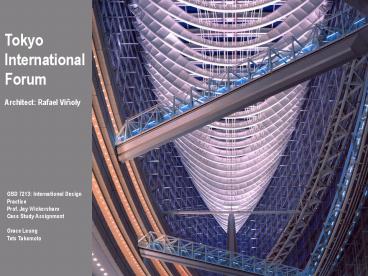Tokyo - PowerPoint PPT Presentation
1 / 30
Title: Tokyo
1
Tokyo International Forum
Architect Rafael Viñoly
GSD 7213 International Design Practice Prof. Jay
Wickersham Case Study Assignment Grace
Leung Tets Takemoto
2
Competition and Program
3
A New Civic and Cultural Center for Tokyo
- proposed by the Tokyo Metropolitan Government in
1989 at the height of Japans economic boom - governor Shunichi Suzuki calls for a new symbol
of Japans economic prosperity as well as a
global meeting ground where citizens of Tokyo
can meet with other people from all over the
world. - Japans first international competition
4
The Program
- hybrid cultural activities with a business
focus - 4 theaters ranging from 350-5,000 seats
- business convention facilities, conference
centers, offices - cultural retail, mediatech, galleries,
cinemas, library - 4.000 sq. meter open public plaza
- pedestrian connections between two major trains
stations capable of exceeding 7 million people
per day
5
International Design Competition
- jury I.M. Pei, Kenzo Tange, Arthur Erickson,
Fumihiko Maki, and Vittorio Gregotti - drew 395 entries from 50 countries
- 1st place Rafael Vinoly
- 2nd place Tomohisa Yuri (floating hall)
6
International Design Competition
- exceedingly well-balance solution for the
programmatic requirement. Among the works, it is
the most site-specific. jury - when realized, this project will give Tokyo an
urban space of a form and scale that it has not
yet known. Maki
7
Site and Cultural Effects
8
Site Context
- trapezoidal site
- in heart of Tokyos CBD
- close to important business districts and
cultural and commercial centers, Imperial Palace - proximity to two major train stations
- historically rich site
9
Economic Background
- height of Japans economic bubble
- in 1991, cost of construction 768 million
- Vinolys fee 7 or 56 million highest
commission ever in Japan - costs escalated to 1.65 billion
- recession - 1992
10
Design Intentions
- Japanese politeness with Western expressiveness
- rare green, urban, open space
- ground level public space encourages meandering
11
Design Intentions
- .building elements align with existing urban
geometries - blank, solid expanse facing railroad tracks
- blend in with surroundings
12
Architect and Client Relationship
13
Viñolys Relationship with TMG
- enthusiastic client we felt we must help him
realize his vision - Vinoly obtained license in Japan became
architect of record - bi-monthly commutes between Tokyo and New York
14
Team of Local and International Consultants
- east-west partnerships
- Local Japanese Architectural Consultant Masao
Shiina - Engineering Structural Design Group Umezawa
Structural Design Laboratory Hanawa Structural
Design Sasaki Structural Planning Laboratory
Yokoyama Structural Design - Consulting firms
- Acoustics J.H.S. Acoustics Yamaha Acoustical
Research - Lighting Engle Lighting Consultants Yutaka
Inaba - Landscaping ALP
- Signage Plants Associate
- Cost estimation Futaba Quantity Survey
- Mechanical Electrical P.T. Morimura Assoc.
- Mechanical transportation John Van Deusen
Assoc. - Stage Mechanism/Lighting Jules Fisher Assoc.
15
The Role of the Contractors
- construction begins in 1992
- two contractors
- Taisei Corp. (theater block)
- Obayashi Corp. (glass exhibition hall)
- Vinolys office led construction management
16
Role Diagram
17
Construction Process and Dynamic
18
Dynamic Sequence of Construction
- from traditional linear sequence to a more
dynamic collaboration process - maximizing use of technology
- architects, engineers, consultants, and
contractors all work within a 3-story building on
site
19
Dynamic Sequence of Construction
- large scale models and mock-ups
- developing details in conjunction with
consultants and engineers
20
Japanese Construction Methods
21
Japanese Construction Methods
22
Influence of Local Climate and Environment
- Tokyo is prone to earthquakes and major typhoons
- carefully engineered exposed steel and glass
structure - columns use new Japanese steel making technology
- introverted scheme
23
Japanese Building Technology
24
Overall Assessment
25
Praise
- this public space is exceptionally permeable . .
. a protected public forum in the center of
Tokyo that is surely comparable to the historic
role played by the Piazza San Marco in Venice.
Kenneth Frampton - The Glass Hall is not a church and this is 20th
century Japan, not 13th-century France. But
this is as good as space gets without age and
religion to mold its character. Muschamp of
the New York Times
26
Criticism
- the idea of an international competition is
fine but it is always decided by a majority
which after all selects faultless, modest
projects. Tomohisa Yuri - I am writing to you to ask what is this alien
object in front of Yurakucho station? as I found
your name on it. Akira Suzuki (in a letter to
Governor of Tokyo)
27
Justification for the Forum?
- ambitious program brief
- Why Tokyo?
- The job of an architect is basically to design a
space that is faithful to the given program. I do
not believe an architect is not responsible for
how that program works. Rafael Viñoly
28
Viñolys Final Words
- The Tokyo International Forum is a reminder of
the opportunities and challenges that come with
the internationalization of architectural
practice and emphasizes the importance of an
interactive relationship between the architects
and construction companies and the client.
Rafael Viñoly
29
Effectiveness of Japanese Model
- dissolution of disciplinary boundaries
- Japanese model one architect controlling
design and construction - technical resources
- great attention to detail, craft and precision
30
The End
Tokyo International Forum































